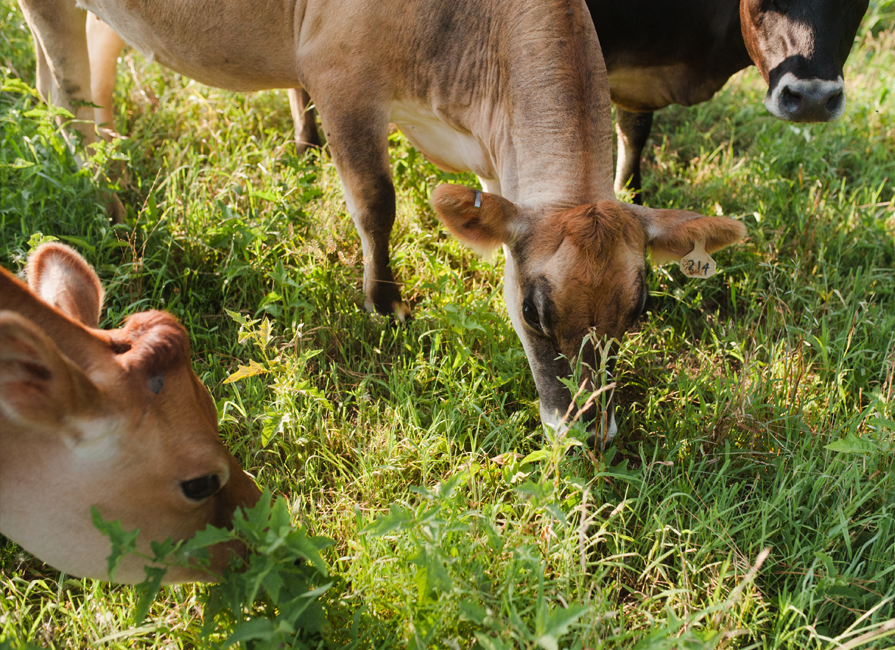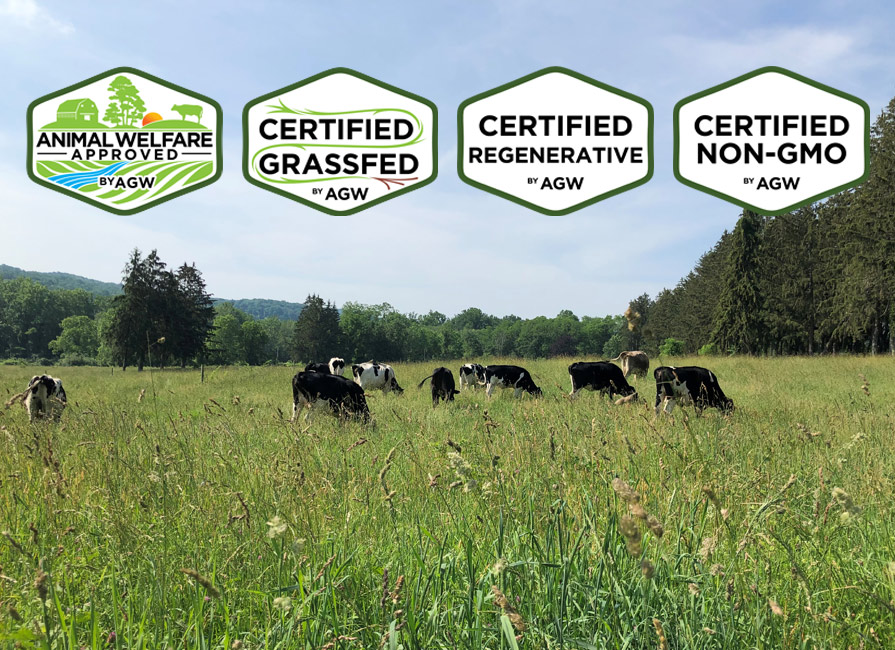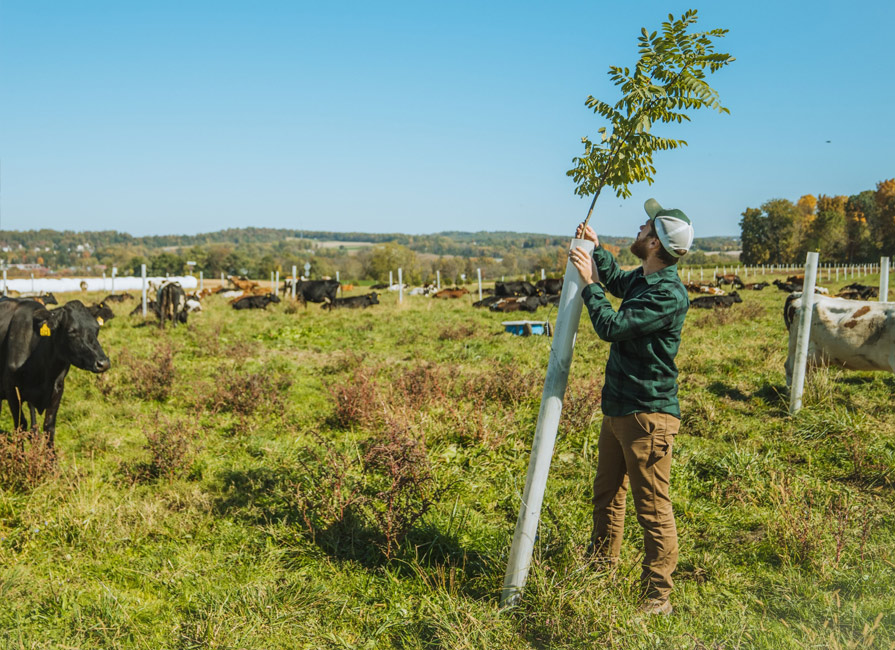Zach and Christina Menchini own Campfire Farms, 30 acres of pasture and woodland near Mulino…

Hunger Games
Research shows that feeding ruminants small quantities of grain is not usually harmful. If they are fed large quantities of grain, however, ruminants can suffer from serious diet- and digestion-related problems such as acidosis (a serious form of bovine heart burn that can lead to diarrhea, ulcers, liver disease and general ill health).
Besides being detrimental to animal welfare, feeding grain also raises concerns about livestock competing directly with humans for food sources. On this basis, A Greener World advocates for maximizing grass and forage in ruminant diets for positive welfare, as well as reducing reliance on grains that could otherwise be used for human consumption, specified in the Certified Animal Welfare Approved by AGW standards.
How much grain?
So how do farmers determine the right balance of feed for ruminants? It all starts with understanding dry matter. Dry matter (DM) is what remains after all water is evaporated from a given feed.
Since different feeds have varying DM content, it is essential to compare them on a like-for-like basis to make accurate calculations. For example, fresh pasture has a much lower DM and a higher moisture content (MC) than an equivalent weight of dry hay.
In order to work out the correct animal intake, compare different feed sources on a like-for-like basis, and then calculate different diets, we need to first work on a dry matter basis, before we work out the fresh weight of different feeds.
The daily dry matter intake (DMI) of ruminants is generally related to their liveweight. The Certified Animal Welfare Approved by AGW standards provide a simplified approach for different ruminant species, making the calculations (relatively!) straightforward for farmers and ranchers in the program.
Percentage of body weight equivalent to DMI
- Beef cattle = 2.5%
- Non-lactating dairy cattle = 2.5%
- Lactating dairy cattle = 3%
- Meat goats and meat sheep = 3%
- Non-lactating dairy goats and dairy sheep = 3%
- Lactating dairy goats and dairy sheep = 5%
- Bison = 2.5%
Using this general information listed in the standards, it is now possible to work out the approximate DMI for individual or groups of similar animals.
Working out the daily DMI
Example 1: A lactating dairy cow weighs 1,000 lb. Her total daily DMI is 3 percent of her body weight (1,000 lb x 0.03 = 30 lb). The cow’s total daily DMI will be 30 lb.
Example 2: A group of 20 ewes are fed as one group. They weigh between 130–150 lb. with a group average of 140 lbs. Each ewe’s daily DMI will be 3 percent of her body weight (140 lb x 0.03 = 4.2 lb). 20 ewes total daily DMI will be 84 lb.
Using the daily DMI figures
Certified Animal Welfare Approved by AGW standards limit the amount of non-forage feed that can be given to ruminants for animal welfare reasons (and to avoid livestock competing directly with humans for feed grains).
Standard 6.1.1 requires that beef cattle, non- lactating dairy cattle, meat goats and non-lactating dairy goats, meat sheep and non- lactating dairy sheep, and bison receive a minimum of 70 percent forage in the diet to ensure proper rumen function.
Standard 6.1.2 requires that lactating dairy cattle, dairy sheep and dairy goats have a minimum of 60 percent forage in the diet to ensure proper rumen function.
This means that beef cattle, non-lactating dairy cattle, meat goats and non-lactating dairy goats, meat sheep and non-lactating dairy sheep, and bison could receive a maximum of 30 percent of their daily dry matter intake (DMI) in the form of grain and other non-forage feeds. Likewise, lactating dairy cattle, dairy sheep and dairy goats could receive up to a maximum of 40 percent of their daily dry matter intake (DMI) in the form of grain and other non-forage feeds. (Note: standards 6.1.1 and 6.1.2 apply for every day of the animals’ lives – not the total feed over their lifetime.)
While it is difficult to calculate exactly how much forage a grazing animal might eat on a daily basis, it is relatively easy to work out how much non-forage food is being provided—and what proportion of the daily DMI this comprises.
So, rather than working out how much forage the animal needs to eat each day to remain compliant, it is far simpler to work out the maximum non-forage feed that can be given and ensure animals are not given more than this each day.
Working examples
To comply with AGW standards, most ruminants should be fed at least 70 percent forage in their diet on a daily basis. (For lactating dairy cattle, dairy sheep, and dairy goats, this percentage should be at least 60 percent.) Rather than focusing on calculating the exact amount of forage consumed each day, farmers can determine the maximum non-forage feed allowed, and ensure the animals do not exceed this limit.
Example 3: A lactating dairy cow weighs 1,000 lb. Her daily DMI is approximately 1,000 x 0.03 = 30 lb. The Certified Animal Welfare Approved by AGW standard requires at least 60 percent of her daily DMI to be forage, and allows a maximum 40 percent DMI as non-forage feed like grain. So, 40 percent of her 30 lb total daily DMI is 30 x 0.4 = 12 lb. The cow could therefore have up to 12 lb on a DM basis of non-forage feed per day.
Example 4: A group of 20 ewes weigh on average 140 lb. The daily dry matter intake for each ewe is therefore 140 x 0.03 = 4.2 lb. The Certified Animal Welfare Approved by AGW standard requires at least 70 percent of each ewe’s daily DMI to be forage, and allows for a maximum 30 percent DMI as non-forage feed like grain. 30 percent of each ewe’s 4.2 lb total daily DMI is 4.2 x 0.3 = 1.26 lb. The group of 20 ewes could therefore be given 25.2 lb dry matter of non-forage feed per day.
Converting DMI into fresh weight
As already discussed, different feeds have different DM values. Most grains, for example, have an average DM around 85 percent (the remaining 15 percent being moisture). In other words, using example 3 above (the lactating dairy cow weighing 1,000 lb), if the 12 lb dry matter per day of non-forage feed was given as a mix of grains, the 12 lb of mixed grains would represent only 85 percent of the fresh weight of those grains. In other words, more mixed grain could be fed.
Example 5: A 1,000 lb lactating dairy cow has a maximum daily DMI of non-forage feed of 12 lb. The feed is a mix of grains. We know the DM of mixed grains is about 85 percent. The fresh weight of the maximum amount of grain that can be fed to the cow per day is therefore 12/0.85 = 14.1 lb.
Example 6: A group of 20 ewes has a maximum daily DMI of non-forage feed of 1.26 lb per ewe (25.2 lb for the group). We know the DM of mixed grain feed is 85 percent. The fresh weight of the maximum amount of grain that can be fed per day is 1.26/0.85 = 1.47 lb per ewe per day (1.26/0.85 x 20 = 29.4 lb for the group per day).
Non-grain non-forage feeds
If you are intending to use non-grain feeds in the diet, various nutritional charts are available in feed books or online to help determine the dry matter content. For example, feedtables.com is an extremely comprehensive resource and provides the dry matter content for most available feeds, including:
- Cottonseed meal = 90% DM
- Beet pulp (dry) = 89% DM
- Dried brewers grains = 92% DM
- Soybean meal = 90% DM
Putting it all together
The following examples show the ruminant feed calculation process from start to finish.
Example 7: How much fresh grain can I feed a 150 lb lactating dairy doe and remain within the Certified Animal Welfare Approved by AGW standards? Looking at the liveweight/DMI table in the standards, the bodyweight to equivalent DMI for a dairy doe is 5 percent. So, 150 x 0.05 gives the estimated total daily DMI of 7.5 lb.
The maximum non-forage is 7.5 x 0.4 (40 percent), which equals 3 lb. Fresh grain is 85 percent DM, so 3/0.85 gives a maximum fresh weight grain ration for a dairy doe of 3.52 lb per day.
Letting animals choose their feed
AGW standards remain consistent, whether the farmer measures the feed intake daily or allows the animals to choose freely from troughs or feeders. When using feed hoppers filled less often, it is essential to account for the number of animals in the group and the time between each filling.
Example 8: A group of 20 beef finishers are all fed together in one group. The average weight of the animals is 800 lb and their total daily DMI is 20 lb. The maximum non-forage feed per day is 30 percent of 20 lb = 6 lb. The non-forage feed is a sweetmix with a DM content of 85 percent. The maximum fresh weight of sweetmix per animal per day is: 6/0.85 = 7.06 lb. The maximum fresh weight of sweetmix per day for the 20 cattle is: 7.06 x 20 = 141.2 lb. If the feed hopper is only filled once a week the maximum amount of grain that could be given is 141.2 x 7 days = 988.4 lb.
IF IN DOUBT
By following AGW’s standards and calculating feed intake carefully, farmers can ensure the well-being of their ruminant animals while promoting sustainable farming practices. With a focus on maximizing forage and minimizing grain usage, we can support a greener and healthier world for both animals and humans alike.
And if you are ever in any doubt about what you are feeding your animals, please get in touch. We are here to help.
This article is based on a technical factsheet (TAFS) written by Anna Heaton for Certified Animal Welfare Approved by A Greener World, which provides full reference tables for types and weights of animal. Download at agreenerworld.org.
Originally published in the Fall 2023 issue of AGW’s Sustainable Farming magazine.



